A novel technique reduces complications and improves patient satisfaction
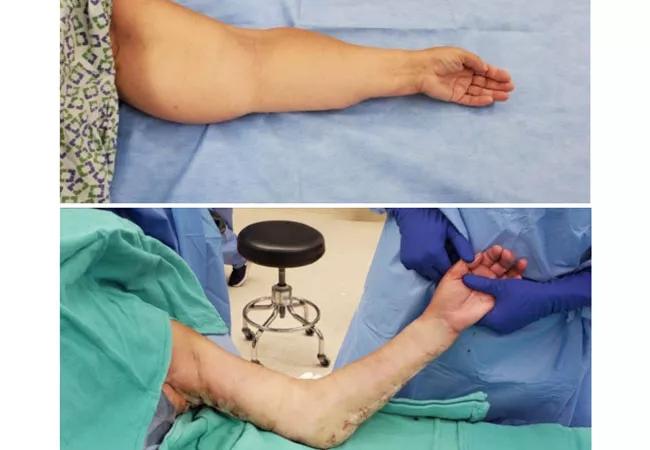
Lymphedema liposuction (commonly known as suction-assisted protein lipectomy, or SAPL) is a highly effective treatment for treating advanced solid-predominant lymphedema. It has helped make treatment a less invasive process, and it can provide relief to patients who either faced a lifetime of swelling and pain or major surgery before. Furthermore, liposuction not only removes lymphedema-induced fatty deposit, but it also stimulates lymphatic regeneration.”
Advertisement
Cleveland Clinic is a non-profit academic medical center. Advertising on our site helps support our mission. We do not endorse non-Cleveland Clinic products or services. Policy
But patients who have large amounts of abnormal fat and fiber build-up removed can have excess skin left after lymphedema liposuction. That excess skin can create complications, says Wei Chen, MD, FACS, Head of Regional Microsurgery and Supermicrosurgery, Co-Director of the Center for Lymphedema Research and Reconstruction in the Cleveland Clinic Department of Plastic and Reconstructive Surgery.
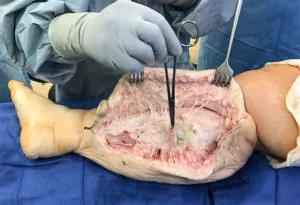
By making an incision and removing skin excess, the surgeon gains access to compromised tissue that may not be removable with liposuction.
To address this problem of excess skin after surgery, Dr. Chen pioneered a procedure called the “flying squirrel” liposuction technique. The name comes from the resemblance of the post-liposuction appearance of the skin to the animal when it is in flight. The technique involves thorough lymphedema liposuction followed by immediate skin excision – the same kind of skin excision a plastic surgeon performs as part of a cosmetic abdominoplasty, or arm or leg lift.
In a paper published in the journal Plastic and Reconstructive Surgery – Global Open, Dr. Chen compared patients who had traditional lymphedema liposuction to those who underwent the “flying squirrel” liposuction. He found that the “flying squirrel” liposuction cohort had significantly fewer occurrences of seroma/hematoma, contour irregularity and skin necrosis. The “flying squirrel” patients also reported higher satisfaction with the results.
“Most often, complications from traditional lymphedema liposuction come not from the surgery, but from what happens after,” he says. “Compression is required as part of recovery following the surgery. However, if you compress a leg or an arm with a lot of loose skin, they’ll fold upon themselves and strangle blood flow.” This folding can result in skin necrosis. Patients may also suffer from seroma/hematoma and irregular contouring of the extremity post-surgery, causing a deformed look, even after treatment.
Advertisement
The argument against skin removal, which is favored by practitioners of traditional lymphedema liposuction, is that that skin will naturally shrink on its own.
“This flies in the face of our understanding of how skin responds to volume changes,” says Chen. “If women don’t always lose abdominal skin excess after pregnancy, and people with massive weight loss often opt for their skin excess be surgically removed, then lymphedema patients shouldn’t expect to experience miracle skin shrinkage either, especially since they lose so much volume so quickly through this kind of liposuction.”
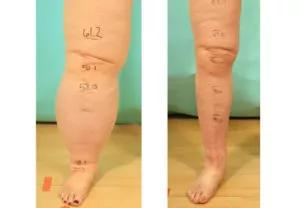
Before and after leg comparison following ‘”flying squirrel” liposuction.
To date, Dr. Chen has successfully treated hundreds of patients suffering from advanced solid-predominant lymphedema with the “flying squirrel” liposuction. His patients have experienced none of the complications associated with traditional lymphedema liposuction without skin excision, and his patients have been ecstatic with the results.
He also works with patients who had surgery completed elsewhere and were not satisfied with the results. He found the reason for their suboptimal results frequently being overly conservative removal of the lymphedema-induced fat and fibrosis. The conservative approach, while safe, leaves too much pathologic tissue behind, and does not sufficiently reduce lymphedema symptoms. This not only leads to patient dissatisfaction, but it can often result in complication.
“These patients are seeking out a second surgery because their arms or legs still do not look and feel normal,” he says. “The “flying squirrel” allows us to thoroughly remove not just fatty and fibrotic tissue excess, but also skin excess as well. In doing so we are able to normalize the patients’ arms or legs.”
Advertisement
Skin excision adds approximately 30 minutes to each surgery, but it has no effect on recovery time. Patients are admitted for one to two days for pain management. Post-operative therapy starts one day after surgery and includes instruction on proper bandaging technique. Patients are also told to use the treated limb lightly for four weeks post-surgery.
“Our “flying squirrel” technique removes the skin excess during the same surgery and our study shows it produces superior outcomes and is safer,” says Dr. Chen. “The complication rates essentially reduce down to nearly zero.”
Following successful “flying squirrel” liposuction, patients may choose to combine “flying squirrel liposuction with additional reconstructive procedures. Some of these procedures include vascularized lymph vessel transfer (VLVT), a supermicrosurgical derivative of the more established vascularized lymph node transfer (VLNT), or supermicrosurgical lymphaticovenular anastomosis (LVA) to further reconstruct and improve their lymphatic system.
“Currently few surgeons around the world are performing the “flying squirrel” liposuction technique, but people are beginning to switch over,” says Dr. Chen. “I believe there’s going to be a gradual shift from the conventional technique to our technique because it produces results lymphedema patients often feel overwhelmingly happy with. And who would not want their patients to be happy?”
Advertisement
Advertisement
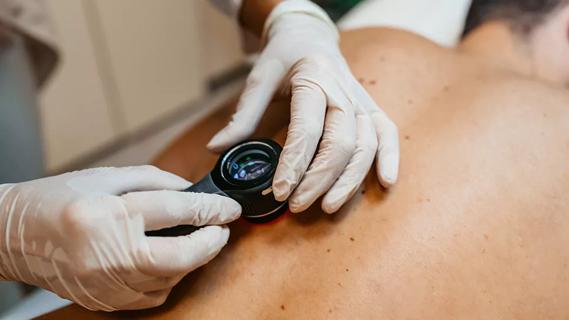
Family history may eclipse sun exposure in some cases
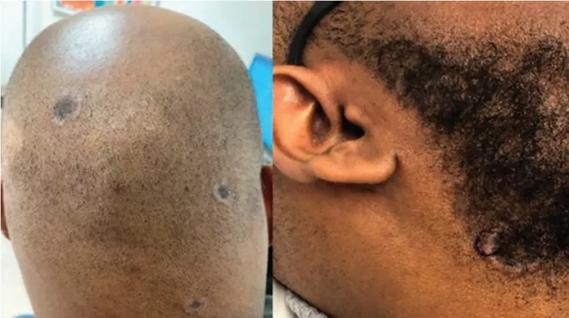
Consider secondary syphilis in the differential of annular lesions
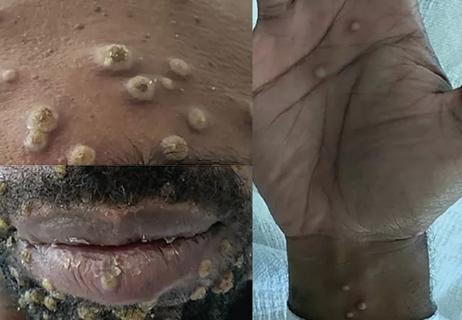
Persistent rectal pain leads to diffuse pustules

Techniques are borrowed from rhinoplasty, malar augmentation and others

Two cases — both tremendously different in their level of complexity — illustrate the core principles of nasal reconstruction

Stress and immunosuppression can trigger reactivation of latent virus

Low-dose, monitored prescription therapy demonstrates success

Antioxidants, barrier-enhancing agents can improve thinning hair